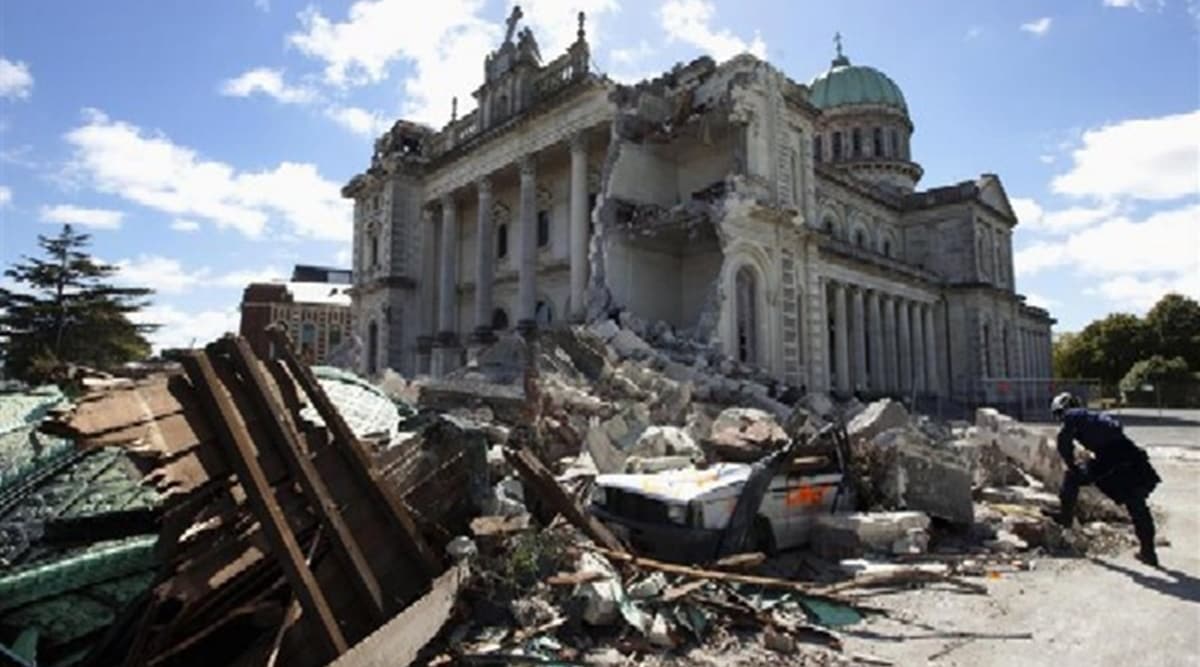 The Christchurch Cathedral is to Christchurch what The Empire State Building is to New York.
The Christchurch Cathedral is to Christchurch what The Empire State Building is to New York. Tuesday. February 22, 2011. Like most New Zealanders, it’s a date that Frankie Mackay, a Canterbury all-rounder and member of the White Ferns team would not forget anytime soon. It was a day when a major earthquake measuring 6.3 on the Richter Scale had sent shockwaves across South Island, striking at the heart of Christchurch in Canterbury region, New Zealand’s second-most populous city, causing wide-spread devastation and claiming as many as 185 lives.
Ironically, the day had begun on a hopeful note for Mackay, then 21, who was informed that she would be making her debut against Australia in the upcoming ODI series. Shortly before 1 pm, the team assembled at their hotel at Cathedral Square for a practice session. She had just walked towards the hotel lobby towards the door when the ground beneath her began to shake vigourously. An alarmed Mackay wrapped herself around a pillar in the lobby. Her team-mates outside had lost their sense of physical perspective when a large chunk of the magnificent Christchurch Cathedral’s tower had caved in. When the quaking stopped, none of team members were injured, but they were covered with dust from the debris. They gathered gingerly outside the hotel premises, where some preferred to sit down as that made them feel a lot safer. Mackay added: “There were White Ferns team curled in little balls in the middle of the Square.”
A team-mate began to remove the rubble to see if anyone was trapped beneath. Mackay recalled seeing fire bellowing from the adjacent Press Building, home of Christchurch’s morning newspaper, which had collapsed. When she saw people coming out with blood on their faces, the enormity of the situation sunk in. It was not just the beloved Cathedral. “You think, ‘we’re in a world of trouble here.’”
Mackay would go on to assert herself as an all-rounder with big-hitting prowess and parsimonious off-spin bowling. Between 2011-2014, she was a regular with the New Zealand Women’s ODI and T20 squads, a period in which she travelled to the 2012 T20 World Cup in Sri Lanka and the 2013 One-day World Cup in India. A subsequent loss in form relegated her to the sidelines. After a five-year hiatus, she returned for the T20 series at home against India after being named the Burger King Super Smash Women’s Player of the Year at the annual New Zealand Cricket awards that season.
 Frankie Mackay.
Frankie Mackay.
A decade since that horrific natural calamity, Trevor Auger, a former club cricketer based in Auckland, had released a book titled: “The Warm Sun on My Face: The Story of Women’s Cricket in New Zealand,” which among other things, chronicled vividly, the events from that cool, mid-summer February afternoon. Interestingly, Auger had not planned to include this section in his book before meeting Mackay in 2018. “My conversation with Mackay moved me profoundly. She was the catalyst, and it’s her account that I chose to write in detail in this book,” Auger told The Indian Express over the phone.
The 676-pager, which was in the making for more than four years, documents women’s cricket in New Zealand from the late 19th century to the current legends of the White Ferns team.
Auger was not in Christchurch or any other part of South Island when tragedy struck. Nevertheless, he offered several anecdotal evidence of the mayhem and deep scars the chain of events had left in the minds of people. “When the earthquake struck, I was working for the Ford Motor company in Auckland. But several colleagues from Ford’s Christchurch dealership recounted how the front of a nearby building toppled onto a bus and crushed several people,” he explained.
Apart from the loss of many innocent lives, the earthquake, Auger said, was also responsible for wiping out the erstwhile Lancaster Park and partially devastating the Christchurch Cathedral — two monumental landmarks in the city. “The Lancaster Park was integral to the city’s sporting ecosystem, with the venue regularly hosting international cricket and rugby matches. The earthquake had caused irreparable damage. It was only after this incident that the Hagley Oval was refurbished and put on the cricketing map. It hosted Sri Lanka in 2015, and then the World Cup that year,” Auger, who had worked as a press scorer at Auckland’s Eden Park, offered.
‘The heart of the city is broken’
For the past 10 years, the Christchurch Cathedral, an imposing neo-gothic structure, built by popular English architect Sir Gilbert Scott, has been standing amongst debris and rubble, with its tower ravaged. Peter Beck, the cathedral dean, had told the BBC: “The heart of the city is broken.”
“It was built by immigrants from England when they arrived in New Zealand in the 19th century. For long, this structure has been the identity of this city. Just like New York has the Empire State Building, Christchurch is known for its namesake: the Christchurch Cathedral,” Auger noted. “Not sure when the restoration work will begin. There’s a lot of debate over who will pay for it.”
Even after all these years, there are many New Zealanders, who are still grappling with the after-effects. “Even now, when there’s even a slight tremor, my sister and nephew get very concerned,” Auger stated.
 Trevor Auger, a former club cricketer based in Auckland.
Trevor Auger, a former club cricketer based in Auckland.
Former White Ferns cricketer Elizabeth Perry was among the many who were physically and emotionally drained by the events of February 22, 2011. Perry represented White Ferns at the international level for seven years from 2010 to 2017 as a competent seam-bowling all-rounder. Apart from her stints in cricket, she also represented New Zealand internationally at hockey. In April 2019, Perry married New Zealand cricketer Maddy Green.
She was also simultaneously pursuing her Master’s thesis at the time on: ‘The travelling female athlete: cricket, migration and globalization’. The subject of her study involved experiences of female athletes from New Zealand and Australia who migrate temporarily to play cricket in England. It located the migration network of female cricket within the modern global sport space and challenged the overall perception of what the typical global athlete is today. At one point, she considered giving up her research and cricket too, before family and friends helped her through that period.
“This thesis has been a continual reminder of that day for me because of its connections to cricket, but I firmly believe that if it was not for this research I may not have continued my cricket career at all,” Auger quoted her in his book.